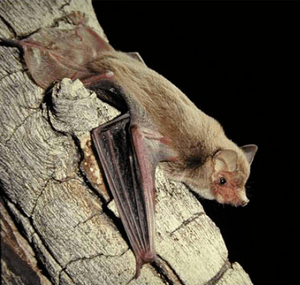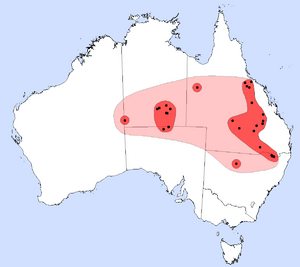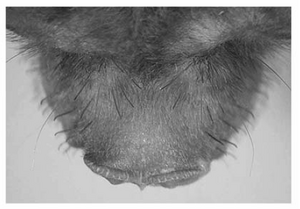Setirostris facts for kids
Quick facts for kids Setirostris eleryi |
|
|---|---|
 |
|
| Conservation status | |
| Scientific classification | |
 |
|
| Setirostris eleryi range in 2014 | |
| Synonyms | |
|
Setirostris eleryi is a small bat that eats insects. You can find it in the inland parts of eastern Australia. It is the only species in its group, called Setirostris. This name means "bristle snout" because of the stiff hairs on its face. People used to call it the 'bristle-faced freetail bat'. This name describes its unique face and its tail, which sticks out freely from its body.
This bat is special because it has unique teeth and body parts. Its echolocation calls (the sounds it makes to find things) are also different. It is very small, weighing only about 5 grams. The stiff bristles on its thin snout help tell it apart from other similar bats. Scientists first described this bat in 2008. They compared its body features with its family tree to understand how it was related to other bats. This helped them find "hidden species" among bats that looked very similar.
Setirostris eleryi might live across a large part of inland Australia. This includes very dry areas and wetter, warmer regions. However, it is not common in any one place. It prefers to live near rivers and on floodplains. During the day, these bats sleep in tree hollows of old eucalypt trees. They can also squeeze into other tiny cracks. They form groups of up to twenty bats. Sometimes, bats of other species join their groups.
Contents
How Scientists Named This Bat
In 1988, scientists studied the genes of Australian free-tailed bats. They found that Setirostris eleryi was one of eight different genetic groups. At first, they called it 'form sp 6' or Mormopterus sp. 6. This group was genetically different from all others.
Later, scientists found more bats of this type. They studied 24 more bats from museums and by trapping them. In 2008, they officially described Mormopterus sp. 6. They looked at its body, used genetic tests, and studied its echolocation calls. After 2011, it was finally recognized as its own species, Mormopterus (Setirostris) eleryi.
|
|||||||||||||||||||||||||||||||||||||||||||||||||||||||||||||||||||||
| How S. eleryi is related to other Australian Mormopterus bats. The three new groups are shown. |
Studies showed that Setirostris eleryi and Micronomus norfolkensis are not closely related to other Australian bats in the Molossidae family. Because of these differences, scientists created four new groups in 2014. One of these new groups was Setirostris, which holds only S. eleryi. Another new group was Ozimops, which includes seven other Australian bats.
The first bat specimen used to describe the species was found near Eringa Station in South Australia. The name Setirostris comes from Latin words meaning "bristle" and "snout." The name eleryi honors Elery Hamilton-Smith, who helped a lot with bat research.
People have called this bat by several names. These include hairy-nosed free-tailed bat, bristle-faced freetail bat, and Mormopterus sp. 6.
What Does This Bat Look Like?
Setirostris eleryi is a very small bat with a light body. It was considered tiny compared to other small bats. It usually weighs about 5.2 grams, but can weigh up to 8 grams. Its forearm is about 31.5 to 36 millimeters long.
Its face and snout are quite long and narrow. The muzzle and face have fine, sparse hair. But it has a special feature: 26 to 30 clear bristles on each side of its face. It also has a furry fringe on its upper lip.
The ears are shaped like triangles and do not connect across the forehead. The tragus (a small flap in the ear) is rounded. The fur on its back is sandy-brown to grey-brown. Its belly is lighter in color.
Since S. eleryi is the only species in the Setirostris group, it has unique features. It does not have a developed throat pouch. It has two lower incisor teeth instead of three. It also has two upper premolar teeth instead of one. These features help tell it apart from other bats.
Where Does This Bat Live?
Setirostris eleryi is rare but spread out across large parts of inland Australia. Scientists have found it in central Australia, the southwestern Northern Territory, northern South Australia, western and central Queensland, and northwestern New South Wales (NSW).
It lives in a wide range of climates. This includes very dry areas in central Australia, where it rains less than 200 mm a year. It also lives in parts of northeastern Queensland, where it can rain over 1000 mm a year. In eastern Australia, it lives west of the Great Dividing Range. In western Australia, it lives in areas like the Finke River and MacDonnell Ranges.
Scientists think this bat might live in even more dry and semi-dry areas. This includes parts of NSW, Queensland, the Northern Territory, and Western Australia. However, we still don't know much about where it lives and how many there are. By 2008, it had been found in only 26 places. Not many new locations have been found since then.
What Kind of Home Does It Like?
Scientists usually find S. eleryi using special nets or traps. They catch them in riparian habitats, which are areas along streams, floodways, pools, or dams. These places usually have many eucalypt trees.
The places where they are caught always have trees like Eucalyptus camaldulensis, E. coolabah, E. microtheca, E. populnea, E. polyanthemos, and E. citriodora. In Gundabooka National Park in western NSW, these bats were only found along drainage lines with eucalypt trees.
Studies using radio tracking showed that these bats prefer to hunt for food along drainage lines and open channels. They rarely go into areas with other types of trees. All the places where they sleep during the day were in tall eucalypt trees. These trees were either in or very close to areas near water.
This bat clearly prefers to live near water. For example, in South Australia, it was caught near a floodway with Acacia cambagei trees and Eucalyptus coolabah. In Idalia National Park in Queensland, two bats were caught near water with Eucalyptus camaldulensis and Eucalyptus populnea trees. In northeastern NSW, a bat was caught near a river with Eucalyptus camaldulensis, Eucalyptus blakelyi, and Angophora floribunda trees.
Behavior and Life Cycle
We don't know much about the behavior and life of S. eleryi. There hasn't been much research, especially in the capital territory and New South Wales. Most of what we know comes from a short study done in 2005 at Gundabooka National Park in western NSW.
Where Do They Sleep?
S. eleryi bats sleep during the day in tree hollows. These hollows can be in living or dead tree trunks or branches. All three known roost sites were in tall Eucalyptus populnea or Eucalyptus intertexta trees. They were about 3 to 6 meters above the ground. The entrance holes were very small, only 13 to 20 millimeters wide, leading to a larger room inside.
These roosts were shared with 4 to 20 other bats, sometimes even bats of different species. They sometimes used the same roosts for several nights in a row. The roosts were about 3.2 to 4 kilometers from where the bats were caught. Female bats used separate roosts for giving birth and raising their young.
How Do They Find Food?
Like other similar bats, S. eleryi probably leaves its sleeping spot at night to find food. They fly along drainage lines and open channels. They fly slowly, fluttering close to the ground, about 3 to 4 meters high. They catch flying insects in the air, close to the ground or nearby plants. This way of catching food is similar to how some birds "glean" insects. We don't know exactly what insects S. eleryi eats. Their slow, fluttering flight close to the ground helps tell them apart from other bats.
How Do They Use Echolocation?
The echolocation calls of S. eleryi are different from all other Australian bats in its family. Its calls have a strong, changing frequency. It also has the highest average call frequency (36 kHz) of any Mormopterus bat in Australia.
Reproduction
We have limited information about how S. eleryi reproduces. In December, a roost for mothers was found at Gundabooka National Park. It had 15 female bats that were feeding their babies. A female bat caught in October in the Northern Territory was very pregnant.
Protecting This Bat
Conservation Status
As of 2020, the International Union for the Conservation of Nature lists S. eleryi as a near-threatened species. This means it could become endangered soon. It is listed as endangered in New South Wales and vulnerable in South Australia. In the Northern Territory and Queensland, it is a 'least concern' species. It is not listed on Australian national conservation lists. Because Setirostris is a unique group with only this one species, it is very important to protect it.
How Many Are There?
Setirostris eleryi seems to be very rare across all the areas where it lives. It has been found in only a few places. Even in those places, it is uncommon. It often makes up less than two percent of the bats caught in surveys. In NSW, it has been found in only a few spots, even though many surveys have been done. The way it hunts, flying low along streams, suggests that the low numbers found are because it is truly rare, not just hard to catch.
What Are the Threats?
Things that threaten S. eleryi are mostly caused by humans. These include:
- Clearing land
- Cutting down trees
- Changing water sources
- Different fire regimes (how often fires happen)
- Using pesticides
- Farm animals like cows and sheep eating too much
- Spread of feral animals and weeds
- Air pollution that leads to global warming
The biggest threat is probably the ongoing clearing of land in Queensland and NSW. Many areas where this bat lives have been greatly changed since Europeans arrived. Clearing land for farms and removing hollow trees for firewood or timber reduce places for bats to sleep. These actions are known to be major threats to the species in NSW.
Other threats include:
- Changes to natural water flow.
- Competition from introduced western honey bees for tree hollows.
- Fires that happen at the wrong time or too often.
- Less insect food because of pesticides.
- Lack of new trees growing due to too much grazing by animals and weeds.
Climate change can also affect bats. It can change where they live, how they move, and when they reproduce. S. eleryi lives in dry areas near water. This makes it sensitive to water shortages and extreme weather events. This bat is at higher risk from climate change because it relies on water-side habitats, eats insects it catches in the air, sleeps in tree hollows, and doesn't travel far.
Protected Areas
Setirostris eleryi has been found in several protected areas. These include Gundabooka National Park (NSW), Kwiambal National Park (NSW), Dthinna Dthinnawan National Park (NSW), Idalia National Park (QLD), Mariala National Park (QLD), and Witjira National Park (SA). However, only about 25% of the places where this bat is known to live are protected.
- NSW Threatened Species Profile for Mormopterus eleryi [1]
- NSW Scientific Committee Endangered species listing Mormopterus eleryi - final determination [2]
See also
 In Spanish: Mormopterus eleryi para niños
In Spanish: Mormopterus eleryi para niños



